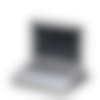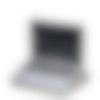Designing the Desk Shelf System - Part One
To design something for the workspace, sometimes you have to go to the workspace.
It had been four years since we’d launched our original desk collection. It was time to take the next step and add to the collection. One early Spring weekend in 2017, Ken camped out in the workshop and started building, toying with different shapes and ideas.
KEN TOMITA (Co-Founder): My design style is to build things without thinking too much.

On Monday morning, the design team gathered around his desk to see what he’d made.
SEAN KELLY (Lead Product Designer): I’ll be honest. It looked really strange.

Ken had taken two Walnut Monitor Stands, removed a leg from each, and joined them together, creating a double-wide stand with an impressive span. It supported his 27” iMac just fine—but it looked funny.

When stretched, the monitor stand proportions started to look off. In a way, seeing the oddness of the double wide stand was a testament to why the original monitor stand was so successful. The proportions are such that it’s hard to imagine a better way, it’s a simple form that works.
But, as our eyes were set on bigger things, we needed to step out from our past designs and make something new!
But, as our eyes were set on bigger things, we needed to step out from our past designs and make something new!
A Handful of Sparks
We wanted to make something beautiful, something that would inspire your best work—and something that was really functional.
Ken and Sean decided to take it to the streets, to look at how people actually worked. They visited them in the spaces where they worked, to try to understand their needs better and to create a more ideal solution for their workspace.
Ken and Sean decided to take it to the streets, to look at how people actually worked. They visited them in the spaces where they worked, to try to understand their needs better and to create a more ideal solution for their workspace.
As the cherry blossoms bloomed, they set out all across town, from creative offices (Uncorked Studios), to coworking spaces (WeWork), to a good friend’s design company (Krownlab).
All told, they visited 11 offices and studios.
After each visit they’d recap and digest what they’d seen and who they’d talked to. Sometimes, over a delicious ice-cream cone. Each trip gave them a new spark of inspiration.
All told, they visited 11 offices and studios.
After each visit they’d recap and digest what they’d seen and who they’d talked to. Sometimes, over a delicious ice-cream cone. Each trip gave them a new spark of inspiration.

Overall, they saw more than 600 desks. This was the most intentional, ethnographic research we’d conducted at Grovemade—it felt great to really focus on the real world needs of our customers. And, we were incredibly appreciative of all the people we visited. They took time out of their days to let us into their world… no small favor!

“It was funny, almost every person was immediately embarrassed about their desk when we started looking at it. Their desks didn’t reflect the quality of their work at all."
KEN TOMITA
Co-Founder
It seems obvious now, but in order to create an actual solution for your desk, we had to start by looking at… your desks!
SEAN KELLY: We all struggle with the same thing. We’re all kind of the same way about our desks, seeing it made me feel empathy. Desks are private, but also very public, especially in an office setting.

New Workspaces, New Problems
The workspace was evolving, and there were new hurdles to organization and ergonomics. This time, it was really about screen management and organization. Screens were growing. Bezels were shrinking. Laptops were everywhere.

KEN TOMITA: We’d seen all kinds of DIY solutions for supporting multiple monitors while clearing up desk space. Seeing DIY solutions usually means there’s a gap in the market, something that a well designed product could fill.


We’d seen lavish offices, with expensive desks and storage options that no one used. Uninspiring workspaces housed within beautiful, brand new buildings. And, as always, there was stuff everywhere—the never ending quest to banish stuff continues!
There are lots of office solutions out there, and if you asked people what they need at their desk, you’d get plenty of answers. But a funny thing happens when you observe, listen, and look, without asking. You can find problems people didn’t know they had, and create solutions they didn’t realize they needed. And usually, those solutions are the ones that are most crucial.
So, Ken and Sean absorbed and dissected all the research and observations, and got to designing.
There are lots of office solutions out there, and if you asked people what they need at their desk, you’d get plenty of answers. But a funny thing happens when you observe, listen, and look, without asking. You can find problems people didn’t know they had, and create solutions they didn’t realize they needed. And usually, those solutions are the ones that are most crucial.
So, Ken and Sean absorbed and dissected all the research and observations, and got to designing.
The Shelf
After finishing the research, Ken came in again on the weekend and started making stuff! On Monday, Sean took what Ken had built, and hacked and improved and rebuilt it. A shelf structure quickly evolved. We realized it was a simple solution, and probably the best one—a long flat surface, large enough to support multiple monitors and provide ample open desk space underneath.
But how to support it? Sean worked through a variety of shapes and materials to design legs for the desk shelf. He started toying around with cork leftover from a previous product, and presented a concept for a solid cork leg to Ken.
But how to support it? Sean worked through a variety of shapes and materials to design legs for the desk shelf. He started toying around with cork leftover from a previous product, and presented a concept for a solid cork leg to Ken.
KEN TOMITA: I liked the functionality—it was pressure fit, meaning no hardware for assembly—but I really didn’t like the look.

SEAN KELLY: Ken and I had worked together long enough that I knew when to stop working on a concept... and when I needed to just keep pushing to refine it a bit more.

The cork surface was too distracting, too busy. The grain was too large. It wasn’t elegant. Sean took the feedback, but rather than abandoning the humble new material, he kept designing and refining on his own. He saw potential there, and just needed the time to work on it and present it in a new light...
Meet the Players
Each piece is available individually, allowing you to mix and match to dial in your desk.








































